Text
Discovering Banff: A Guide to Wilderness Exploration

Banff National Park is a site of unmatched beauty and wonder, tucked away amid the untamed grandeur of the Canadian Rockies. Banff is more than simply a park—it's a monument to the unadulterated strength and amazing beauty of nature, spanning over 6,641 square kilometers of pure wilderness. Banff has a wide range of experiences that enthrall the spirit and capture the soul, from its towering peaks to its glistening lakes. We'll explore the numerous attractions, activities, and seasonal variations of Banff National Park in this all-inclusive itinerary.
Discovering Banff's Natural Splendor
At the heart of Banff's allure lies its diverse and awe-inspiring landscapes. Towering mountain peaks, cascading waterfalls, and emerald-green forests create a tapestry of natural beauty that is nothing short of breathtaking. One of the park's most iconic features is Lake Louise, whose turquoise waters reflect the surrounding glaciers and snow-capped peaks with stunning clarity. Nearby, Moraine Lake captivates visitors with its vibrant hues and dramatic setting, earning its place as one of the most photographed locations in the Canadian Rockies.

For those seeking adventure, Banff's extensive network of trails offers endless opportunities for exploration. From leisurely strolls through verdant valleys to challenging ascents up rugged mountain peaks, there's a hike for every skill level and inclination. Johnston Canyon Trail, with its scenic pathways and breathtaking waterfalls, is a favorite among visitors of all ages. Meanwhile, the Plain of Six Glaciers Trail rewards intrepid hikers with panoramic views of glaciers and alpine meadows, showcasing the park's untamed beauty in all its glory.
Engaging Activities for Every Season
Banff National Park is a playground for outdoor enthusiasts, offering a plethora of activities to suit every interest and season. In the winter months, the park transforms into a winter wonderland, with world-class skiing and snowboarding opportunities at resorts such as Lake Louise and Sunshine Village. The crisp mountain air and pristine snow-covered landscapes create an idyllic setting for snowshoeing, ice skating, and ice climbing while cozying up by a crackling fire with a cup of hot cocoa is the perfect way to unwind after a day of exploration.

As the snow melts and spring arrives, Banff bursts to life with vibrant colors and renewed vitality. Wildflowers blanket the meadows, and the sound of rushing water fills the air as rivers and waterfalls swell with the melting snow. Spring is the perfect time for wildlife viewing, as bears, elk, and other native species emerge from their winter slumber in search of food and mates. Guided wildlife tours offer the chance to observe these magnificent creatures in their natural habitat while learning about the park's delicate ecosystem and conservation efforts.
Summer in Banff is a time of endless adventure and outdoor pursuits. Hiking, biking, and rock climbing are popular activities, with trails ranging from easy family-friendly walks to challenging backcountry treks. The park's pristine lakes and rivers provide ample opportunities for kayaking, canoeing, and paddleboarding, while fishing enthusiasts can cast their lines in search of trout and other native species. Camping under the stars is a quintessential summer experience, with campgrounds nestled amidst towering pines and breathtaking mountain vistas.
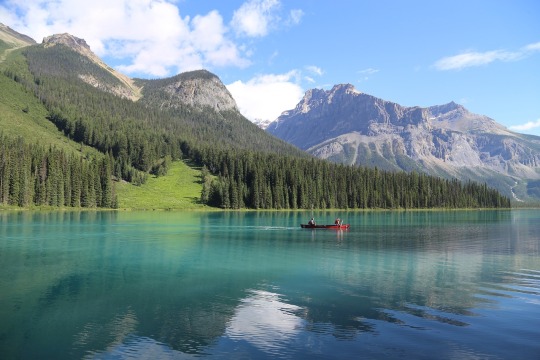
Timing Your Visit: Seasons and Climate
The best time to visit Banff National Park largely depends on the activities you wish to pursue and your tolerance for crowds and varying weather conditions. Summer (June to August) is the busiest time of year, with long daylight hours and mild temperatures ideal for hiking, camping, and wildlife viewing. However, be prepared for crowds and book accommodations well in advance, especially if you plan to visit popular attractions like Lake Louise and Moraine Lake.

Winter (November to April) transforms Banff into a snowy paradise, with world-class skiing and snowboarding drawing winter sports enthusiasts from around the globe. The ski season typically peaks between December and February, offering optimal snow conditions and a wide range of terrain for skiers and snowboarders of all levels.
Spring (April to June) and fall (September to October) offer a quieter and more tranquil experience, with milder temperatures and fewer crowds. Spring is particularly beautiful, with wildflowers in bloom and wildlife emerging from hibernation, while fall brings vibrant foliage and crisp mountain air, making it an ideal time for hiking and photography.
Banff’s weather is characterized by cold winters and mild summers. Winter temperatures can plummet well below freezing, with heavy snowfall common in the higher elevations. Summer temperatures are generally mild, with daytime highs averaging around 20-25°C (68-77°F) in the valleys, although temperatures can vary significantly depending on elevation.
It's important to come prepared for changing weather conditions, especially if you plan to explore the higher elevations. Dressing in layers and packing essential gear such as waterproof clothing, sunscreen, and insect repellent will ensure a comfortable and enjoyable experience.
Conclusion: Embrace the Adventure
Banff National Park is more than just a destination; it's an experience that awakens the senses and nourishes the soul. Whether you're drawn to its rugged mountain peaks, tranquil lakes, or abundant wildlife, Banff offers a wealth of opportunities for exploration and adventure. From exhilarating outdoor pursuits to moments of quiet reflection amidst nature's grandeur, Banff invites visitors to immerse themselves fully in its timeless beauty and create memories that will last a lifetime. So pack your bags, lace up your hiking boots, and embark on a journey of discovery in one of the world's most awe-inspiring wilderness destinations. Banff awaits, ready to enchant and inspire all who venture into its embrace.
0 notes
Text
From Romans to Royals: Discovering Bath's Iconic Monuments

Bath City is a monument to centuries of rich history and cultural significance, nestled amid the gorgeous countryside of Somerset, England. Bath has enthralled tourists with its breathtaking architecture, thermal springs, and ageless charm since it was founded as a Roman spa town and is now recognized as a UNESCO World Heritage Site. Together, we will delve into Bath's past, learning about its historical sites, when is the ideal time to come, and its pleasant climate.
A Glimpse into the Past
Bath's history dates back over two millennia when the Romans first recognized the therapeutic qualities of its natural hot springs. They constructed elaborate baths and a temple complex dedicated to the goddess Sulis Minerva, transforming the area into Aquae Sulis, a flourishing spa town.
Following the Roman occupation, Bath experienced periods of decline and resurgence, with its fortunes fluctuating through the medieval and Tudor eras. However, it was during the Georgian period in the 18th century that Bath truly flourished. Under the guidance of architects like John Wood the Elder and his son, John Wood the Younger, the city underwent a remarkable transformation. Elegant crescents, terraces, and squares adorned with honey-colored Bath stone emerged, defining the city's iconic architectural style.
Historical Monuments to Explore
The Roman Baths: A visit to Bath would be incomplete without exploring the Roman Baths, one of the best-preserved ancient spas in the world. Wander through the atmospheric ruins, marvel at the intricate Roman architecture, and learn about the city's Roman heritage through interactive exhibits and artifacts.
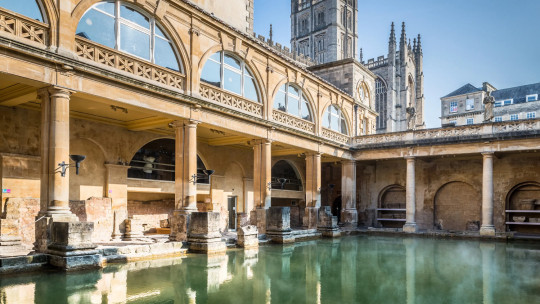
Bath Abbey: Standing proudly in the heart of the city, Bath Abbey is a masterpiece of medieval architecture. Admire its stunning perpendicular Gothic façade, intricate stained glass windows, and soaring vaulted ceilings. Don't miss the opportunity to climb the tower for panoramic views of Bath's skyline.
The Royal Crescent: Regarded as one of the finest examples of Georgian architecture, the Royal Crescent is a sweeping crescent-shaped row of terraced houses overlooking Royal Victoria Park. Take a leisurely stroll along the crescent, marveling at its uniformity and elegance, or visit No. 1 Royal Crescent, a meticulously restored Georgian townhouse museum.
Pulteney Bridge: Spanning the River Avon, Pulteney Bridge is an architectural gem designed by Robert Adam in the 18th century. Its distinctive shops built into the bridge's structure add to its unique charm, making it a popular spot for a scenic riverside walk or a spot of shopping.

The Circus: Designed by John Wood the Elder, The Circus is a circular arrangement of townhouses adorned with neoclassical motifs. Stand in the center and admire the symmetry and grandeur of this architectural marvel, which is often hailed as one of Bath's most iconic landmarks.
The Best Time to Visit
Bath City weather is characterized by mild summers and cool winters. Summer temperatures range from 15°C to 25°C (59°F to 77°F), while winter temperatures average between 1°C to 8°C (34°F to 46°F). Rainfall is spread throughout the year, with October and November being the wettest months.
While Bath is a delight to explore year-round, the optimal time to visit largely depends on personal preferences and interests. Summer, particularly from June to August, is the peak tourist season when the city comes alive with festivals, outdoor events, and vibrant street performances. The weather is generally mild and pleasant, perfect for leisurely walks and alfresco dining in the city's charming squares and gardens.
Spring (March to May) and autumn (September to November) also offer favorable conditions for visiting Bath. During these seasons, the city experiences fewer crowds, allowing visitors to explore its attractions at a more relaxed pace. The blooming flowers in spring and the vibrant hues of autumn foliage add an extra layer of beauty to Bath's already picturesque landscape.
Winter (December to February) brings a festive atmosphere to Bath, with Christmas markets, twinkling lights, and cozy fireside pubs creating a magical ambiance. While temperatures may dip, the city's thermal springs provide a comforting retreat, making it an ideal time to indulge in a relaxing spa experience.
Conclusion
Bath City is a treasure trove of history, architecture, and natural beauty, offering visitors a glimpse into its illustrious past and vibrant present. Whether you're wandering through ancient Roman ruins, admiring Georgian splendor, or soaking in the healing waters of its thermal springs, Bath's timeless allure is sure to leave a lasting impression. So, plan your visit, immerse yourself in the city's rich heritage, and experience the magic of Bath in every season.
0 notes
Text
A Culinary Journey Through Stockholm: Exploring Rich Flavors in Every Season

Stockholm, the vibrant capital of Sweden, is a city that offers more than just stunning architecture and picturesque waterfronts. For the food enthusiast, Stockholm is a haven of culinary delights waiting to be discovered. A culinary journey as varied as its seasons awaits you in Stockholm, where you can find everything from modern, inventive food to centuries-old, traditional meals.
Seasonal Flavors: A Taste of Stockholm's Weather
Stockholm's weather plays a significant role in shaping its culinary landscape. The city experiences four distinct seasons, each offering a unique bounty of ingredients that inspire chefs and home cooks alike.
Spring (Vår)
As winter recedes, Stockholm awakens with a burst of fresh flavors. Spring brings a sense of renewal, reflected in the dishes that grace tables across the city. Look for dishes featuring the tender, young shoots of asparagus, the first harvests of flavorful wild garlic, and the delicate sweetness of freshly sprouted peas. In restaurants and homes, you might find classics like 'Vårkänslor' (Spring Feelings), a dish celebrating the season with new potatoes, pickled herring, and sour cream.

Summer (Sommar)
Stockholm summers are a time of abundance, with long days that seem to stretch endlessly into twilight. This season brings a bounty of berries—lingonberries, blueberries, and the coveted wild strawberries. These berries find their way into jams, desserts, and savory dishes alike. Seafood shines in the summer, with crayfish parties (kräftskiva) a beloved tradition. Imagine tables filled with boiled crayfish, Västerbotten cheese pie, and crisp, fresh salads.
Autumn (Höst)
As the leaves turn golden and the air becomes crisp, Stockholm's forests offer a treasure trove of mushrooms and game. Chanterelles, porcini, and the elusive 'black gold' of truffles make their way into hearty stews and creamy sauces. Autumn also marks the beginning of the apple and pear season, with orchards heavy with fruit. Indulge in warm apple pie topped with vanilla sauce or explore the savory side with pork dishes accompanied by tart apple compote.
Winter (Vinter)
Winter transforms Stockholm into a winter wonderland, with snow-covered streets and a cozy atmosphere. It's a time for hearty, warming meals that fortify against the cold. Classic dishes like 'Ärtsoppa med Pannkakor' (Pea Soup with Pancakes) are a comforting staple, especially on Thursdays, a tradition dating back to the 15th century. Rich, meaty stews like 'Köttbullar' (Swedish meatballs) served with lingonberry sauce evoke cozy evenings by the fire.

Traditional Staples and Modern Innovation
While exploring Stockholm's culinary landscape, one encounters a blend of tradition and innovation. The city has a deep-rooted respect for its culinary heritage, evident in dishes that have stood the test of time. Yet, Stockholm's chefs are also at the forefront of culinary innovation, constantly pushing boundaries while maintaining a focus on local, seasonal ingredients.
Traditional Dishes:
Smörgåsbord: A quintessential Swedish dining experience, featuring a vast array of dishes from pickled herring to cured meats, cheeses, and savory pies.
Gravlax: This cured salmon dish, typically served with dill and mustard sauce, is a celebration of the city's abundant seafood.
Surströmming: For the adventurous, this fermented herring is a pungent delicacy best experienced outdoors due to its potent aroma.
Modern Takes:
New Nordic Cuisine: Inspired by the principles of using local, sustainable ingredients, this movement has put Stockholm on the global culinary map. Restaurants like the renowned "Fäviken" and "Oaxen Krog" epitomize this ethos.
Foraging Culture: With access to pristine forests and coastline, foraging plays a significant role in Stockholm's cuisine. Chefs and home cooks alike venture into the wild to gather ingredients like wild herbs, berries, and mushrooms, adding a fresh, earthy dimension to their dishes.
Exploring Stockholm's Food Culture
Exploring Stockholm's cuisine goes beyond just tasting the food. It's about immersing oneself in the culture that surrounds it. Visit local markets, such as Östermalms Saluhall or Söderhallarna, where vendors proudly display their fresh produce, meats, cheeses, and seafood. Engage with locals to learn about family recipes passed down through generations, or join in seasonal celebrations like Midsummer, where traditional foods are central to the festivities.
Fika: The Stockholm Art of Coffee Breaks
No exploration of Stockholm's culture would be complete without experiencing 'fika'. More than just a coffee break, fika is a cherished tradition of pausing, savoring a hot beverage (usually coffee or tea), and enjoying a sweet treat. Indulge in cinnamon buns (kanelbullar), cardamom-scented cakes, or almond tarts as you join Stockholmers in this daily ritual of relaxation and socializing.

In conclusion, Stockholm's culinary scene is a tapestry woven with the threads of tradition, innovation, and the rich bounty of its seasons. Whether you're savoring the tangy sweetness of lingonberries in summer or warming up with a steaming bowl of pea soup in winter, every bite tells a story of this beautiful city. So, pack your curiosity and appetite, and embark on a culinary journey through Stockholm—you'll discover a world of flavors waiting to be explored.
1 note
·
View note
Text
Exploring the Enchanting Ice Caves of Eisriesenwelt in Werfen, Austria

Nestled within the heart of the Austrian Alps, near the picturesque town of Werfen, lies a world that seems plucked from the pages of a fairy tale—Eisriesenwelt, the "World of the Ice Giants”. This majestic ice cave system, one of the most famous in the world, beckons adventurers and nature lovers alike to explore its frozen wonders. From its ancient ice formations to its mysterious depths, Eisriesenwelt offers a truly enchanting experience for those willing to venture into its icy embrace.
A Geological Marvel
Eisriesenwelt, which translates to "Giant Ice World”, is a labyrinth of ice and rock that stretches over 42 kilometers (26 miles) deep into the Hochkogel Mountain. However, only the first kilometer of the cave system is open to the public for exploration. Despite its limited accessible area, visitors are treated to a mesmerizing display of natural ice sculptures, stalactites, and stalagmites.

Location and Accessibility
Located about 40 kilometers (25 miles) south of Salzburg, Eisriesenwelt is easily accessible by car or public transportation from major cities in Austria. From the charming village of Werfen, visitors can embark on a scenic hike up the mountain to reach the entrance of the ice cave.
The journey to the entrance itself is an adventure, as it involves a steep ascent along a winding path. The trail offers stunning views of the Salzach Valley below, with snow-capped peaks in the distance. Along the way, the anticipation builds as visitors catch glimpses of the icy wonderland awaiting them.
The Ice Cave Experience
Upon reaching the entrance, visitors are greeted by an awe-inspiring sight—the massive portal of the cave, framed by towering cliffs of rock and ice. Stepping inside, the temperature drops dramatically, and the air becomes infused with the crisp scent of ancient ice.
Guided tours are the only way to explore Eisriesenwelt, ensuring both safety and an informative experience. Knowledgeable guides lead visitors through narrow passages and expansive chambers, pointing out remarkable ice formations along the way. The caves are illuminated with artificial lighting, casting an ethereal glow on the translucent ice.

Highlights of Eisriesenwelt
The Ice Organ (Eisorgel): One of the most famous formations in Eisriesenwelt is the Ice Organ, a series of hollow ice stalactites that create musical tones when tapped. The echoing sounds reverberate through the cavern, adding to the magical atmosphere of the cave.
The Great Ice Embankment (Große Eiskapelle): This grand chamber, with its towering ice formations resembling frozen waterfalls, is a highlight of the tour. The sheer scale of the ice walls leaves visitors in awe of the forces of nature that created them.
The Ice Palace (Eispalast): As the tour continues deeper into the cave, visitors encounter the Ice Palace, a chamber filled with delicate ice formations that sparkle like diamonds in the light. This ethereal space feels like a hidden realm from a fantasy novel.

Tips for Visiting Eisriesenwelt
Dress Warmly: The cave remains at a constant temperature below freezing, so layers, warm jackets, hats, gloves, and sturdy shoes are essential.
Book in Advance: During peak tourist seasons, it's advisable to book guided tours in advance to secure your spot.
Photography: Cameras are allowed, but be mindful of the low light conditions and respect any restrictions on flash photography.
Physical Fitness: The hike to the entrance and the tour itself involves some physical exertion, so visitors should be in moderate physical condition.
Local Weather and Conditions
The weather in the Austrian Alps, where Eisriesenwelt is located, can be quite variable and should be taken into consideration when planning a visit. In the summer months, temperatures can range from 10°C to 25°C (50°F to 77°F) in the valley, but it's important to note that temperatures inside the ice cave remain below freezing year-round.
During the winter, from November to March, the region experiences colder temperatures, with average lows ranging from -5°C to -15°C (23°F to 5°F). Snowfall is common, especially at higher elevations, so visitors should be prepared for potentially icy conditions on the trail leading to the cave entrance.
Before embarking on the journey to Eisriesenwelt, it's recommended to check local weather forecasts and trail conditions. Sudden weather changes can impact accessibility and safety, particularly on the steep hike to the cave entrance.
A Frozen Wonderland Awaits
As visitors emerge from the depths of Eisriesenwelt, they carry with them memories of a journey into an otherworldly realm of ice and stone. The natural beauty and grandeur of the ice cave leave an indelible impression, reminding us of the remarkable forces that shape our planet.
Exploring Eisriesenwelt is not just an adventure; it's a glimpse into the Earth's ancient history and a tribute to the wonders of nature. For those seeking a magical and unforgettable experience, the ice caves of Eisriesenwelt stand as a testament to the beauty and power of the natural world.
1 note
·
View note
Text
Under the Northern Lights: A Photographic Journey in Norway

In the heart of Norway's Arctic Circle, a celestial spectacle unfolds when the night sky dances with hues of green, purple, and blue. The Northern Lights, or Aurora Borealis, draw adventurers and dreamers from around the globe to witness this natural wonder. Join us on a journey through Norway's pristine landscapes as we chase the elusive Northern Lights.
Location: Norway's Arctic Circle
Located within the Arctic Circle, Norway's Arctic region offers the perfect canvas for nature's light show. Towns like Tromsø and Alta, nestled among snow-capped mountains and fjords, serve as gateways to this ethereal experience. Their charming cabins and hearty cuisine provide a cozy refuge from the Arctic cold, welcoming visitors to this magical land.
Best Locations to Witness the Phenomena:
Tromsø: Known as the "Gateway to the Arctic," Tromsø is one of the best places on Earth to witness the Northern Lights. Its latitude, combined with minimal light pollution, offers ideal conditions for aurora viewing. Tromsø’s weather tracking services are essential for visitors, given the frequent cloud cover of the location. Visitors can take guided tours into the surrounding wilderness or even spot the lights from the city itself.

Alta: Alta, located further north, is another prime location for aurora sightings. The Altafjord provides a stunning backdrop for the dancing lights, and visitors can explore the UNESCO-listed Alta Museum during the day to learn about the region's ancient rock carvings.
Weather: Arctic Cold and Crisp Nights
The Arctic night is not without its challenges. Temperatures in winter can plunge well below freezing, reminding us of the raw power of nature. Bundled up in layers of warmth, we embrace the chill, knowing that this discomfort is a small price to pay for such an extraordinary experience. The cold, crisp air heightens our senses, adding to the magic of the moment.
The Dance of Light:
Under the guidance of our expert local guides, we find ourselves in remote locations, far from the city lights that could dim the auroras' brilliance. As the clock strikes midnight, the sky begins its performance. Wisps of light appear, teasing us with their gentle glow. Then, like a symphony, the Northern Lights burst into full display, swirling and twirling across the sky in a mesmerizing ballet of color.

Capturing the Magic:
Photographers eagerly set up their tripods, adjusting settings to capture this fleeting spectacle. The camera's shutter clicks, freezing moments of magic as ribbons of light dance overhead. Each photograph is a testament to the beauty of nature's artistry, a reminder of our small place in this vast universe.
Embracing the Cold:
Despite the Arctic cold, our spirits remain warm as we marvel at the celestial display above. The Northern Lights seem to whisper secrets of the universe, inviting us to contemplate the mysteries of the cosmos. Wrapped in our winter gear, we stand in awe, grateful for this rare opportunity to witness such a natural wonder.

Local Tales and Traditions:
During our daytime explorations, we immerse ourselves in local culture. We listen to Sami tales of reindeer herding and visit traditional villages, where the Sami people have lived for centuries. Their connection to the land is palpable, and we gain a deeper appreciation for the Arctic's rich history.
Conclusion:
In the land of the midnight sun and polar nights, chasing the Northern Lights is a pilgrimage of the soul. Norway's Arctic welcomes adventurers with open arms, inviting them to witness a spectacle that transcends time and space. As we bid farewell to this magical land, we carry with us memories of shimmering skies and the knowledge that, in the dance of the Northern Lights, nature's beauty is truly boundless.
Additional Tips:
Dress warmly in layers and be prepared for cold temperatures.
Book tours with local guides who know the best spots for aurora viewing.
Bring a camera with manual settings to capture the auroras' true colors.
Check the aurora forecast for optimal viewing times.
Respect the environment and local traditions during your stay.
Travelers Note:
For those seeking an otherworldly adventure, Norway's Arctic Circle offers an unparalleled experience. Whether you're a seasoned traveler or a first-time explorer, chasing the Northern Lights in Tromsø or Alta will leave you with memories to last a lifetime.
1 note
·
View note
Text
Chasing Waterfalls: Iceland's Top 10 Natural Marvels

Iceland, with its rugged landscapes and dramatic natural beauty, is a land of fire and ice where waterfalls cascade down cliffs with breathtaking splendor. These cascades are not just geological wonders but also an integral part of Icelandic culture, often woven into folklore and legends. Here are the top 10 waterfalls in Iceland that promise awe-inspiring experiences, alongside insights into the weather and culture that shape this Nordic island nation.
1. Gullfoss (Golden Falls)
Location: South Iceland
Gullfoss, known as the "Golden Falls," is one of Iceland's most iconic waterfalls. Here, the Hvítá River plunges into a rugged canyon, creating a mesmerizing spectacle. During winter, the falls often partially freeze, creating icy sculptures that contrast with the surrounding snow-covered landscape. This waterfall is not just a natural wonder but also a symbol of Iceland's environmental activism, as it was saved from hydroelectric development by the efforts of Sigríður Tómasdóttir in the early 20th century.
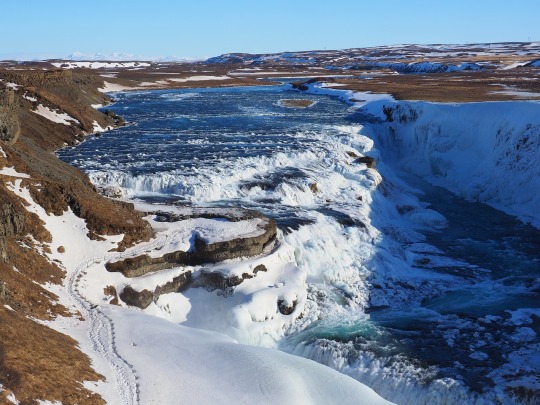
2. Seljalandsfoss
Location: South Iceland
Seljalandsfoss offers a unique experience as one of the few waterfalls in Iceland where visitors can walk behind the cascading water. This 197-foot fall is particularly magical during the midnight sun of summer when the golden light bathes the landscape. The weather here can change quickly, so visitors should be prepared for sudden rainbows appearing in the mist.

3. Skógafoss
Location: South Iceland
Just a short drive from Seljalandsfoss lies Skógafoss, another impressive waterfall. Plunging 197 feet over a wide cliff, this waterfall is known for its sheer power. Legend has it that a Viking settler buried a treasure chest behind the falls, but it was never found. Nearby, the Skógar Museum offers insights into Iceland's cultural heritage, with exhibits on traditional turf houses and artifacts from Iceland's history.
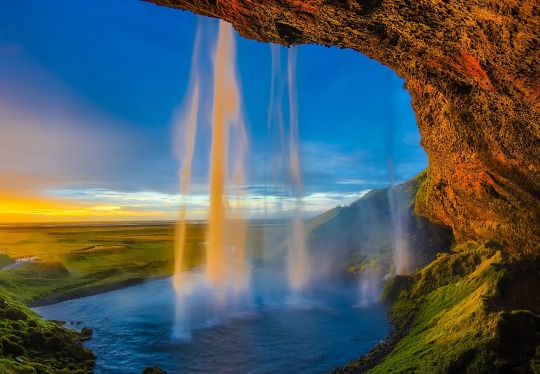
4. Dettifoss
Location: Northeast Iceland
Dettifoss is Europe's most powerful waterfall, with a massive flow of water that thunders into the Jökulsárgljúfur canyon. Its sheer force creates a mist that can be seen from miles away. This area, part of Vatnajökull National Park, is a rugged wilderness of volcanic landscapes and is a stark contrast to the lush greenery often associated with waterfalls.
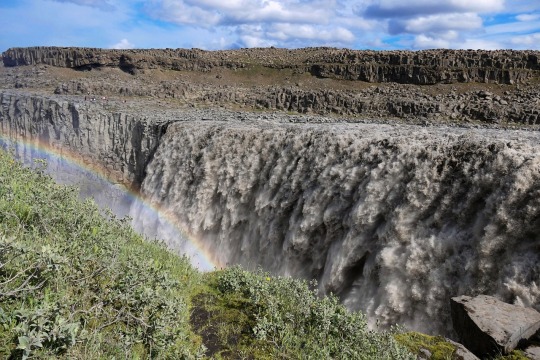
5. Svartifoss (Black Falls)
Location: Skaftafell, Vatnajökull National Park
Svartifoss is renowned for its striking basalt columns surrounding the cascade, creating a unique and dramatic backdrop. These columns, resembling organ pipes, inspired the architecture of Reykjavik's Hallgrímskirkja Church. To reach Svartifoss, visitors take a scenic hike through the rugged landscapes of Vatnajökull National Park, offering a glimpse into Iceland's raw natural beauty.
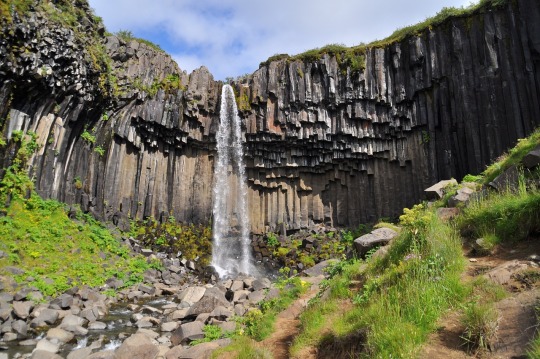
6. Hraunfossar and Barnafoss
Location: West Iceland
Hraunfossar, meaning "Lava Falls," is a series of cascades that flow out of the Hallmundarhraun lava field. What makes this waterfall unique is that the water seems to emerge from the lava itself, creating a mystical sight. Nearby, Barnafoss (Children's Falls) has a tragic legend attached to it, where two children fell to their deaths centuries ago, giving the falls its name. These waterfalls are not just natural wonders but also a testament to Iceland's geological history.

7. Glymur
Location: Hvalfjörður fjord, West Iceland
Glymur is Iceland's second tallest waterfall, tucked away in the remote Hvalfjörður fjord. To reach this hidden gem, visitors embark on a hike through canyons and across rivers, adding an adventurous element to the experience. The trail offers stunning views of the surrounding mountains and fjord, showcasing Iceland's diverse landscapes.

8. Goðafoss (Waterfall of the Gods)
Location: North Iceland
Goðafoss is steeped in history and legend, earning its name from the momentous event when Iceland converted to Christianity in the year 1000. It is said that upon converting, the lawspeaker Þorgeir Ljósvetningagoði threw his statues of Norse gods into the falls, symbolizing the country's adoption of the new faith. This picturesque waterfall on the Skjálfandafljót River is easily accessible from the Ring Road and offers a glimpse into Iceland's cultural evolution.

9. Dynjandi
Location: Westfjords
Dynjandi, often called the "Jewel of the Westfjords," is a cascade of waterfalls that fans out as it descends over 300 feet. The main waterfall, Dynjandi, is the largest and most impressive, surrounded by smaller falls that together create a stunning display of nature's power. Visiting Dynjandi allows travelers to venture into the remote and rugged landscapes of the Westfjords, offering a glimpse into Iceland's untamed beauty.

10. Hengifoss
Location: East Iceland
Hengifoss is known for its distinctive red clay layers that run through the surrounding rock, creating a captivating contrast with the white cascading water. This 128-meter waterfall is a rewarding hike, with the trail passing by another waterfall called Litlanesfoss, known for its basalt columns. As visitors ascend toward Hengifoss, they are treated to panoramic views of the surrounding landscape, including Lake Lagarfljót.

Weather and cultural factors
Iceland's weather is notoriously unpredictable, and travelers should come prepared for anything. Summers, while mild, can still bring sudden rain showers and cool winds, especially near waterfalls where mist can drench unwary visitors. In winter, many waterfalls partially freeze, creating an otherworldly landscape of ice and snow.
Icelandic culture is deeply intertwined with its natural wonders, including waterfalls. Stories of elves, trolls, and hidden people abound, with many waterfalls having their own tales. These tales often carry moral lessons or explanations for natural phenomena. Travelers might hear these stories from locals or encounter them in the many museums dedicated to Icelandic folklore and history.
Visiting these waterfalls of Iceland offers not just a visual feast but also a deeper understanding of the country's geological, historical, and cultural richness. Whether chasing rainbows in the mist of Seljalandsfoss or hiking to the remote beauty of Dynjandi, each waterfall beckons with its own charm, inviting visitors to immerse themselves in Iceland's natural wonders and vibrant heritage.
1 note
·
View note
Text
Stonehenge: Unraveling the Mysteries of an Ancient Icon

Standing majestically on the windswept Salisbury Plain in Wiltshire, England, Stonehenge is a symbol of ancient ingenuity and enduring mystery. Its massive stones, arranged in a circular formation, have captivated the imagination of visitors for centuries, inviting speculation about its purpose and significance. Let's embark on a journey through the history, legends, and significance of this enigmatic monument.
Origins and Construction
Stonehenge's origins trace back over 4,500 years to the Neolithic period, with construction beginning around 3100 BC. Over the centuries, the monument evolved, culminating in the iconic stone circle completed around 2500 BC. The construction of Stonehenge was a monumental feat, involving the transportation of massive stones from distant quarries.
Stone Types:
Sarsens: These are the larger stones that form the outer circle and inner horseshoe at Stonehenge. Some of the sarsens weigh up to 25 tons and were sourced from Marlborough Downs, roughly 20 miles (32 km) away.
Bluestones: The smaller bluestones, which exhibit a bluish hue when wet or freshly cut, are believed to have been transported from the Preseli Hills in Wales, an astonishing distance of about 150 miles (240 km).
Construction Methods:
The methods used to transport and erect these massive stones remain a subject of fascination. Some theories suggest the use of sledges, rollers, and manpower, while others propose the use of wooden sledges on tracks lubricated with water and grease. Regardless of the exact methods, the construction of Stonehenge stands as a testament to the engineering prowess of its ancient builders.

Purpose and Theories
The purpose of Stonehenge continues to elude definitive explanation, leading to a plethora of theories and speculation. Here are some of the most prominent:
Astronomical Observatory: One theory posits that Stonehenge served as an astronomical observatory, aligned with celestial events such as solstices and equinoxes. The alignment of certain stones with the summer and winter solstices suggests a possible connection to tracking the movements of the sun.
Religious and Ceremonial Site: Another widely accepted theory suggests Stonehenge was a sacred site for religious or ceremonial purposes. The monument's alignment with celestial events may have been integral to rituals, ceremonies, and gatherings of ancient societies.
Healing and Spiritual Center: For some, Stonehenge holds spiritual significance and healing properties. Modern-day pagans and druids often gather at the site during significant astronomical events, connecting with ancient traditions and the natural world.
Legends and Folklore: Stonehenge's mystique has also given rise to legends and folklore that add to its allure. According to one legend, Merlin the wizard brought the stones from Ireland and magically set them in place. Another tale suggests that Stonehenge was constructed by giants who danced in a circle until they turned to stone.
Cultural and Historical Importance
Stonehenge's significance extends far beyond its physical presence. It has been designated a UNESCO World Heritage Site since 1986, recognizing its universal value to humanity. Here's why Stonehenge holds such cultural and historical importance:
Symbol of Human Ingenuity: Stonehenge stands as a symbol of human achievement and ingenuity, showcasing the capabilities of ancient civilizations. Its construction required sophisticated planning, organization, and engineering prowess.
Cultural Icon: Stonehenge has become an enduring cultural icon, representing Britain's ancient past. Its image is synonymous with the country, featured on countless postcards, stamps, and travel brochures.
Tourist Attraction and Visitor Experience:
Today, Stonehenge welcomes visitors from around the world, offering a chance to walk in the footsteps of ancient peoples. The visitor experience includes a state-of-the-art visitor center with exhibits that delve into Stonehenge's history, construction, and significance.
Preserving Stonehenge for future generations is a priority, given its age and vulnerability to natural elements and human impact. Efforts are ongoing to ensure the monument's stability and protect its surrounding landscape.
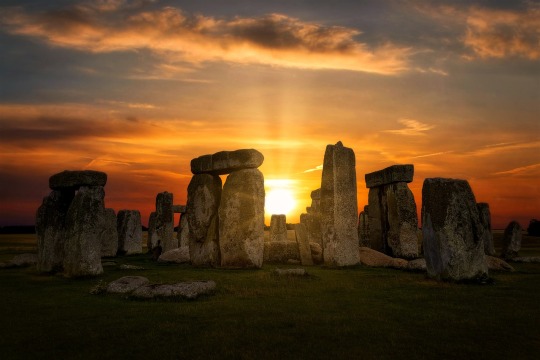
Planning Your Visit
If you're planning a visit to Stonehenge, here are some tips to make the most of your experience:
Tickets: It's advisable to book tickets in advance, especially during peak tourist seasons.
Guided Tours: Consider joining a guided tour led by experts who can provide insights into Stonehenge's history and significance.
Weather: Salisbury’s weather can be windy and exposed, so dress appropriately with layers and sturdy footwear.
Conclusion
Stonehenge stands as a timeless enigma, inviting us to ponder its mysteries and marvel at its ancient origins. Whether you're drawn by its astronomical alignments, its spiritual significance, or its cultural symbolism, a visit to Stonehenge is a journey through millennia of human history. As you stand amidst the towering stones, surrounded by the whispers of ancient legends, take a moment to appreciate the enduring legacy of this remarkable monument. Stonehenge is not merely a collection of stones; it is a gateway to the past, a symbol of human curiosity and ambition, and a testament to the enduring mysteries of our world.
1 note
·
View note
Text
10 Unforgettable Activities in Frankfurt, Germany

Frankfurt, the vibrant heart of Germany's financial sector, is a city of contrasts, blending ancient history with modern innovation. From its iconic skyline to its quaint cobblestone streets, there's a wealth of experiences waiting to be explored. Here are 10 must-do activities to make the most of your time in Frankfurt:
1. Explore the Old Town (Altstadt)
Step back in time and wander through Altstadt, Frankfurt's charming old town. Here, the weather can transform the experience. On a sunny day, the medieval architecture of Römerberg Square shines, with the historic Römer building and its picturesque half-timbered houses casting long shadows. If rain is in the forecast, take shelter in the cozy cafes that line the streets.
2. Visit the Städel Museum
No matter the weather outside, the Städel Museum offers a haven for art enthusiasts. Rainy days are the perfect excuse to immerse yourself in seven centuries of art history, from the Old Masters to modern works, all under one roof.

3. Relax in Palmengarten
As the sun emerges, Palmengarten beckons with its lush greenery and colorful blooms. Bask in the warmth of a sunny day as you stroll through themed gardens, taking in the scents and sights. Should the weather turn cooler, the glasshouses offer a cozy retreat.
4. Enjoy the View from the Main Tower
Weather permitting, a trip to the Main Tower promises breathtaking views of Frankfurt's skyline. On clear days, the panorama extends far and wide, showcasing the city's blend of historic and modern architecture. Even when clouds gather, the cityscape takes on a moody, atmospheric charm.
5. Indulge in Apfelwein (Apple Wine)
Whether the sun is shining or a light drizzle falls, savoring Apfelwein is a quintessential Frankfurt experience. In the lively district of Sachsenhausen, where traditional Apfelwein taverns beckon, locals gather to toast to good company, rain or shine.
6. Explore the Museumsufer (Museum Embankment)
Rainy days offer the perfect excuse to dive into the cultural haven of the Museumsufer. Along the Main River, a cluster of museums awaits exploration. Let the weather guide your choice, whether it's seeking shelter in the Museum für Moderne Kunst (MMK) or enjoying a leisurely stroll through the outdoor sculptures when the sun peeks out.

7. Shop on Zeil
Weather versatility is key when exploring Zeil, Frankfurt's bustling shopping street. On sunny days, the vibrant energy of shoppers fills the air as they browse high-end boutiques and international brands. If rain arrives, the covered passages offer a dry escape without interrupting the shopping spree.
8. Experience the Goethe House
Rain or shine, the Goethe House invites visitors into the world of Germany's literary giant, Johann Wolfgang von Goethe. Wander through the rooms where Goethe lived and worked, gaining insight into his life and legacy.
9. Wander through Kleinmarkthalle
Weather plays a role in the culinary delights of Frankfurt's Kleinmarkthalle. On rainy days, the indoor market buzzes with activity as locals seek out fresh produce and regional specialties. When the sun shines, the market spills outside, inviting visitors to savor local flavors al fresco.
10. Experience a Traditional Apple Wine Tavern
As the weather cools, seek warmth and comfort in a traditional Apfelwein tavern. Here, hearty German fare awaits, from schnitzel to sausages, perfectly paired with tangy Apfelwein. It's a taste of Frankfurt's culinary tradition, regardless of the weather outside.

Whether the sun shines brightly or raindrops dance on cobblestones, Frankfurt's weather is an integral part of the city's charm. It shapes the experiences of locals and visitors alike, adding a layer of unpredictability to each adventure. So, as you embark on these 10 essential experiences, let the weather be your guide, revealing different facets of Frankfurt's allure with each passing day.
1 note
·
View note
Text
Nurturing Growth: The Crucial Role of Meteorology in Agriculture and Farming
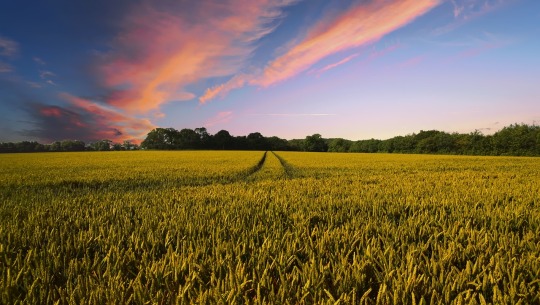
Meteorology, the study of atmospheric phenomena, along with weather forecasts, plays a pivotal role in agriculture and farming. It provides invaluable insights into weather patterns, climatic conditions, and natural events, empowering farmers with the knowledge needed to make informed decisions. From planting crops to managing livestock, meteorological data and accurate weather forecasts serve as guiding lights for maximizing productivity and mitigating risks in the agricultural sector.
Understanding Weather Patterns:
One of the fundamental aspects of meteorology in agriculture is understanding weather patterns. Farmers rely on meteorological forecasts to plan their planting, harvesting, and irrigation schedules. By analyzing temperature fluctuations, precipitation levels, and wind patterns, farmers can optimize their crop cultivation practices. For instance, planting decisions are often based on frost dates and growing degree days, ensuring crops are sown at the most favorable times for optimal growth.
Weather Forecasting for Precision Agriculture:
Weather forecasting plays a crucial role in precision agriculture, where data-driven decisions are made to optimize resource use and increase productivity. Advanced weather forecasting models, coupled with real-time weather data, allow farmers to make precise decisions regarding irrigation, fertilization, and pest management. For example, predictive models can help farmers anticipate periods of heavy rainfall or drought, enabling them to adjust irrigation schedules accordingly and minimize water wastage.
Managing Pest and Disease Risks:
Meteorology and weather forecasting also aid in managing pest and disease risks in agriculture. Certain weather conditions, such as high humidity or prolonged periods of rainfall, can create favorable environments for pests and diseases to thrive. By monitoring meteorological data and weather forecasts, farmers can implement preemptive measures such as timely pesticide applications or crop rotation strategies to minimize the impact of infestations. Additionally, weather forecasts help predict disease outbreaks, enabling farmers to take proactive steps to protect their crops and livestock.
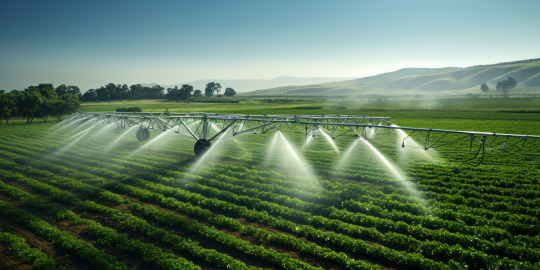
Optimizing Water Resources:
Water is a precious resource in agriculture, and meteorology, along with weather forecasting, plays a crucial role in its efficient utilization. By analyzing rainfall patterns and soil moisture levels, farmers can implement precise irrigation strategies to ensure adequate water supply for their crops while minimizing wastage. Weather forecasts provide valuable information about upcoming precipitation events, allowing farmers to plan irrigation activities accordingly and maximize water efficiency.
Enhancing Crop Yields:
The integration of meteorological data and weather forecasting with modern agricultural technologies has revolutionized crop management practices. Through the use of weather monitoring sensors, satellite imagery, and predictive modeling, farmers can optimize fertilization schedules, crop rotations, and pest management strategies with unprecedented precision. This data-driven approach not only maximizes crop yields but also promotes sustainability by reducing the reliance on chemical inputs and minimizing environmental impact.
Mitigating Climate Risks:
Climate change poses significant challenges to agriculture, including extreme weather events, shifting precipitation patterns, and rising temperatures. Meteorology and weather forecasting play a critical role in helping farmers adapt to these changing conditions by providing early warnings and risk assessments. By understanding long-term climate trends and variability, farmers can implement resilient farming practices such as drought-resistant crop varieties, soil conservation techniques, and diversified farming systems that are better suited to withstand climatic uncertainties.

Conclusion:
In conclusion, meteorology and weather forecasting are indispensable tools for modern agriculture and farming. From predicting weather patterns to managing pest risks and optimizing resource utilization, meteorological data and accurate weather forecasts empower farmers to make informed decisions that enhance productivity, profitability, and sustainability. As the agricultural sector continues to face evolving challenges, the integration of meteorology and weather forecasting with innovative technologies will be key to ensuring food security and resilience in the face of a changing climate.
1 note
·
View note
Text
7 Farming Tips for London with Weather Insights

In the bustling cityscape of London, where skyscrapers punctuate the skyline and parks provide sanctuaries of greenery, urban agriculture is taking root. From rooftop gardens to community allotments, Londoners are embracing the idea of growing their own food in the heart of the city. However, successful farming in an urban environment requires more than just seeds and soil—it also requires an understanding of the unique weather patterns that influence crop growth and garden maintenance. Here are some essential farming tips for London, with insights into weather forecasting to help you make the most of your urban farm.
1. Monitor Microclimates:
London's diverse landscape creates microclimates—localized variations in temperature, humidity, and wind patterns—that can significantly impact plant growth. Use weather forecasting tools and apps to track microclimate data specific to your area, such as temperature variations between sun-exposed rooftops and shaded balconies. This information will help you select the most suitable crops for your microclimate and optimize growing conditions accordingly.
2. Plan Planting Dates:
London's maritime climate is characterized by mild winters and cool summers, but weather fluctuations can occur throughout the growing season. Consult long-range weather forecasts to plan your planting dates strategically, taking into account factors such as frost dates, heat waves, and periods of heavy rainfall. Early spring crops like lettuce and peas can be sown as soon as the soil can be worked, while warm-season crops like tomatoes and peppers should be planted after the risk of frost has passed.

3. Prepare for Extreme Weather Events:
While London generally experiences temperate weather, extreme weather events such as storms, heat waves, and heavy rainfall can pose challenges for urban farmers. Stay informed about weather warnings and advisories issued by the Met Office, and take proactive measures to protect your crops and infrastructure. Consider investing in sturdy trellises and supports for tall plants, securing lightweight containers during windy conditions, and providing shade and adequate hydration during heat waves.
4. Implement Season Extension Techniques:
London's relatively mild climate allows for year-round growing with the help of season extension techniques such as row covers, cold frames, and polytunnels. Monitor weather forecasts for temperature fluctuations and inclement weather that could threaten sensitive crops, and deploy season extension structures as needed to prolong the growing season and protect plants from frost and wind damage.
5. Manage Water Wisely:
Despite London's reputation for rainfall, water management is still a critical aspect of urban farming, especially during dry spells in the summer months. Incorporate weather forecasting into your irrigation schedule, adjusting watering frequency and duration based on predicted rainfall and evapotranspiration rates. Consider installing rain barrels or harvesting rooftop runoff to supplement irrigation water and reduce reliance on municipal water sources.
6. Adapt to Climate Change:
As climate change brings increased variability and unpredictability to weather patterns, urban farmers in London must adapt and innovate to mitigate its impacts. Stay informed about climate projections and trends affecting the region, and explore resilient farming practices such as drought-tolerant crops, soil conservation techniques, and agroforestry systems that harness the benefits of trees and shrubs to enhance ecosystem resilience.

7. Foster Weather Resilience:
Ultimately, successful urban farming in London requires resilience in the face of variable weather conditions. By integrating weather forecasting into your farming practices, staying adaptable, and building community networks for support and collaboration, you can navigate the challenges of urban agriculture and cultivate a thriving, resilient garden in the heart of the city.
In conclusion, weather forecasting plays a crucial role in the success of urban farming in London, helping farmers anticipate and respond to the ever-changing weather conditions that influence crop growth and garden management. By incorporating weather insights into your farming practices and embracing resilient techniques, you can cultivate a flourishing urban farm that not only provides fresh, nutritious food but also contributes to the sustainability and resilience of London's urban landscape. So, embrace the forecast, adapt to the elements, and let your urban farm thrive amidst the dynamic rhythms of the city.
1 note
·
View note
Text
Navigating Airport Codes: Deciphering Three-Letter Location Identifiers

In the bustling world of aviation, where journeys span continents and skies are highways, there exists a cryptic language that unites travelers and aviation professionals alike: airport codes. These three-letter combinations adorn boarding passes, luggage tags, and departure boards, serving as concise identifiers for the multitude of airports worldwide. Yet, behind their seemingly random assortment of letters lies a fascinating tapestry of history, geography, and industry conventions.
The Origin Story:
To understand airport codes, we must journey back to the early days of aviation. As air travel burgeoned in the 1930s, the need for a standardized system to identify airports became apparent. Initially, airports were denoted by two-letter codes, established by the National Weather Service for use in weather reports. However, as air traffic expanded globally, these codes proved insufficient.
In 1947, the International Air Transport Association (IATA) introduced the three-letter system we know today. This system allowed for a significantly larger number of combinations, accommodating the growing network of airports worldwide.
Deciphering the Code:
At first glance, airport codes may seem like an arbitrary jumble of letters, but they often hold significance rooted in geography, history, or language:
Location-based codes: Many codes derive from the airport's name or its geographical location. For instance, LAX for Los Angeles International Airport or JFK for John F. Kennedy International Airport in New York.
Historical significance: Some codes reflect historical names or events. Take ORD for Chicago O'Hare International Airport, a nod to its original name, Orchard Field.
Language and phonetics: In regions where English isn't the primary language, codes may reflect local languages or phonetic sounds. For example, CDG for Paris Charles de Gaulle Airport in France.
Alphanumeric patterns: Occasionally, codes may follow a specific pattern for organizational purposes. For instance, airports in the United States often start with 'K', such as ATL for Hartsfield-Jackson Atlanta International Airport.

Exceptions and Oddities:
While many airport codes follow logical patterns, some exceptions and quirks defy easy explanations. Some codes seem puzzling, such as the code for London's Heathrow Airport, which is LHR, with no apparent connection to its name or location. Similarly, Denver International Airport is DEN, seemingly unrelated to its name or history.
Evolution and Adaptation:
As air travel continues to evolve, so too do airport codes. New airports emerge while existing ones undergo name changes or expansions. This dynamic nature occasionally leads to confusion, especially when codes remain unchanged despite significant alterations to the airport's infrastructure or operations.
Practical Applications:
Beyond their historical and cultural significance, airport codes serve a vital practical function in modern air travel. They facilitate seamless communication between airlines, air traffic control, and passengers, ensuring efficient navigation through the complex web of global aviation.
Weather Forecasts:
In addition to their symbolic importance, airport codes play a crucial role in weather forecasting for aviation. Meteorologists use these codes to provide accurate and timely weather information for pilots, ensuring safe take-offs, landings, and en-route flights. Weather forecasts tailored to specific airports help airlines make informed decisions regarding flight operations, minimizing disruptions and enhancing passenger safety and comfort.

Conclusion:
Airport codes are more than just arbitrary combinations of letters; they are symbols of connectivity, history, and human ingenuity. From the bustling hubs of major metropolises to the remote airstrips of distant islands, these three-letter identifiers serve as beacons in the sky, guiding travelers on their journeys across the world.
So, the next time you glance at your boarding pass or gaze up at the departure board, take a moment to appreciate the rich tapestry of stories woven into those seemingly random letters - the hidden language of the skies, guiding not just flights but also weather forecasts and the safety of air travel.
1 note
·
View note
Text
Exploring How Weather Influences Tourism Trends and Travel Behavior

Weather has always been a dominant force shaping human behavior, and this influence extends profoundly into the realm of tourism. Whether it's the allure of pristine beaches under a scorching sun or the magical charm of winter wonderlands blanketed in snow, travelers are inherently drawn to destinations that offer the climate they desire. In this article, we delve into the intricate relationship between weather patterns and tourism trends, exploring how fluctuations in temperature, precipitation, and seasonal changes impact travel behavior worldwide.
Seasonal Variations:
One of the most apparent manifestations of weather's influence on tourism is the seasonal ebb and flow of travelers. Each season brings its own set of climatic conditions, which in turn dictate the type of experiences and activities available to tourists. For instance, the summer months often see a surge in beach vacations, as people seek relief from the heat by indulging in coastal retreats. Conversely, winter beckons adventure enthusiasts to snowy slopes and cozy chalets, fostering a bustling ski tourism industry.

Regional Preferences:
Beyond seasonal variations, regional weather patterns play a pivotal role in shaping tourism preferences. Countries blessed with year-round sunshine, such as those in the Caribbean or Mediterranean, attract sun-seekers seeking warmth and relaxation. On the other hand, destinations with temperate climates and picturesque landscapes, like New Zealand or Switzerland, cater to outdoor enthusiasts drawn to activities like hiking, cycling, and nature photography.
Extreme Weather Events:
While favorable weather conditions drive tourism, extreme weather events can have the opposite effect, causing disruptions and deterring travelers. Hurricanes, typhoons, wildfires, and other natural disasters can wreak havoc on tourist destinations, leading to temporary closures, flight cancellations, and safety concerns. These events not only impact local economies reliant on tourism but also shape traveler’s perceptions of destination risk and resilience.

Climate Change and Adaptation:
As climate change accelerates, its effects on tourism are becoming increasingly pronounced. Rising temperatures, shifting precipitation patterns, and more frequent extreme weather events pose significant challenges to the tourism industry. Coastal destinations face the threat of sea-level rise and erosion, while mountain resorts grapple with diminishing snowpacks. In response, stakeholders are implementing adaptive measures such as eco-friendly infrastructure, diversification of attractions, and destination marketing strategies that promote sustainability and resilience.
Technology and Forecasting:
Advancements in technology have revolutionized the way travelers plan and experience trips, with weather forecasting playing a crucial role in decision-making. Mobile apps and online platforms provide real-time weather updates, allowing travelers to adjust their itineraries and packing lists accordingly. Additionally, destination marketing organizations leverage weather data to target potential visitors with tailored promotions and seasonal offers, capitalizing on favorable conditions to drive tourist arrivals.
Changing Travel Behavior:
The influence of weather on tourism extends beyond destination selection to impact travel behavior and spending patterns. Inclement weather can disrupt outdoor activities, leading tourists to seek indoor alternatives such as museums, galleries, and culinary experiences. Moreover, extreme heat waves or cold snaps may prompt travelers to prioritize destinations with climate-controlled amenities or opt for off-peak travel times to avoid discomfort and overcrowding.
Conclusion:
Weather exerts a profound influence on tourism trends and travel behavior, shaping destination preferences, seasonal fluctuations, and adaptation strategies within the industry. As climate change continues to alter global weather patterns, stakeholders must prioritize sustainability and resilience to mitigate risks and capitalize on emerging opportunities. By understanding the complex interplay between weather and tourism, destinations can better cater to the diverse needs and preferences of travelers, ensuring memorable experiences regardless of the forecast.
1 note
·
View note
Text
Ensuring Success: Accurate Weather Forecasts for Outdoor Events

Outdoor events, from music festivals and weddings to sports tournaments and community gatherings, offer memorable experiences for participants and spectators alike. However, the success of these events can hinge on one crucial factor: the weather. Unpredictable or severe weather conditions can disrupt schedules, dampen attendance, and even pose safety risks. In this article, we explore the significance of accurate weather forecasts for outdoor events and the strategies event organizers can employ to mitigate weather-related challenges.
The Impact of Weather on Outdoor Events:
Weather exerts a profound influence on the planning, execution, and overall experience of outdoor events. Consider the following scenarios:
Attendance and Revenue: Inclement weather, such as rain, extreme heat, or strong winds, can deter attendees and lead to lower turnout rates. This not only affects the atmosphere and energy of the event but also impacts revenue generation from ticket sales, concessions, and merchandise.
Safety Concerns: Severe weather events, including thunderstorms, lightning, high winds, and heat waves, pose significant safety risks to event attendees, staff, and performers. Poor weather conditions can result in accidents, injuries, and medical emergencies, necessitating swift and effective response measures.
Operational Challenges: Weather-related disruptions can complicate logistical arrangements, such as stage setups, equipment transportation, and vendor coordination. Last-minute changes or cancellations due to adverse weather conditions can strain resources and cause logistical headaches for event organizers.
The Role of Accurate Weather Forecasts:
Accurate weather forecasts serve as invaluable tools for event organizers, empowering them to make informed decisions and implement proactive measures to mitigate weather-related risks. Consider the following ways in which accurate weather forecasts benefit outdoor events:
Planning and Preparation: Long-range weather forecasts enable event organizers to anticipate potential weather hazards and incorporate contingency plans into their event management strategies. By staying abreast of evolving weather patterns, organizers can adjust schedules, secure additional resources, and communicate effectively with stakeholders.
Risk Mitigation: Timely and accurate weather forecasts allow event organizers to implement proactive measures to safeguard the well-being of attendees and staff. This may include providing shelter options, deploying medical personnel, and enforcing safety protocols in response to forecasted weather conditions.
Enhancing the Event Experience: By leveraging accurate weather forecasts, event organizers can optimize the attendee experience and minimize disruptions caused by adverse weather. Strategic planning, such as selecting weather-resistant venues, offering indoor alternatives, and adjusting programming based on forecasted conditions, enhances the overall enjoyment and satisfaction of event participants.
Strategies for Weather Preparedness:
To maximize the success and resilience of outdoor events, event organizers can adopt the following strategies for weather preparedness:
Utilize Reliable Forecasting Tools: Partner with reputable meteorological services or utilize advanced weather forecasting platforms that provide up-to-date and accurate weather information tailored to the specific location and timing of the event.
Develop Comprehensive Contingency Plans: Establish clear protocols and procedures for responding to various weather scenarios, including evacuation plans, communication strategies, and decision-making frameworks for postponement or cancellation.
Maintain Flexibility and Adaptability: Remain flexible and adaptable in response to changing weather forecasts, allowing for real-time adjustments to event schedules, activities, and logistics as needed.
Prioritize Safety and Communication: Prioritize the safety and well-being of attendees, staff, and performers by maintaining open lines of communication, disseminating weather updates promptly, and providing clear instructions for responding to weather-related emergencies.

Conclusion:
Accurate weather forecasts are indispensable assets for the successful planning and execution of outdoor events, enabling event organizers to mitigate weather-related risks and optimize the attendee experience. By leveraging reliable forecasting tools, developing comprehensive contingency plans, and prioritizing safety and communication, event organizers can navigate the unpredictable nature of weather with confidence, ensuring memorable and enjoyable experiences for all participants.
1 note
·
View note
Text
Unveiling the Technological Odyssey: Evolution of Weather Forecasting
Weather forecasting has come a long way from the days of observing the sky and relying on folklore to predict upcoming conditions. Advancements in technology have revolutionized how we perceive, understand, and forecast weather patterns. From the early barometers to modern satellites and supercomputers, each innovation has significantly enhanced our ability to predict weather accurately. Let's take a journey through the evolution of weather forecasting technology and explore how it has transformed over the years.
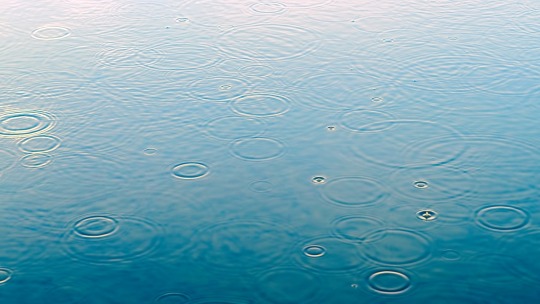
The Early Days:
Before the advent of modern technology, weather forecasting relied heavily on observational data and rudimentary instruments. Ancient civilizations such as the Babylonians, Greeks, and Chinese observed natural phenomena like cloud formations, wind patterns, and animal behavior to predict the weather. These early methods were often based on superstition and lacked scientific validity.
The 17th Century:
The development of the barometer by Evangelista Torricelli in the 17th century marked a significant milestone in weather forecasting technology. This simple device, which measures atmospheric pressure, provided meteorologists with valuable insights into approaching weather systems. The invention of the thermometer by Galileo Galilei further contributed to our understanding of temperature dynamics and their influence on weather patterns.
The Birth of Meteorology:
The 19th century saw the emergence of meteorology as a scientific discipline. Pioneers like Luke Howard, who classified clouds into distinct categories, and Robert FitzRoy, who introduced the concept of weather forecasts, laid the groundwork for modern meteorological research. The invention of telegraphy enabled the rapid transmission of weather data over long distances, facilitating the development of weather observation networks.
The Rise of Radar and Radiosondes:
The early 20th century witnessed the introduction of radar technology, which revolutionized weather monitoring and forecasting. Radar allowed meteorologists to detect precipitation, track storms, and monitor atmospheric conditions in real-time. Concurrently, the invention of radiosondes—balloon-borne instruments equipped with sensors to measure temperature, humidity, and pressure—enabled the collection of upper-air data, essential for forecasting weather systems.
The Space Age:
The launch of the first weather satellite, TIROS-1, by NASA in 1960 marked a new era in weather forecasting. Satellites provided meteorologists with a global perspective of weather patterns, offering unprecedented coverage and data collection capabilities. The integration of satellite imagery into forecasting models improved the accuracy and lead time of weather predictions, especially for severe weather events.
The Digital Revolution:
The advent of computers and numerical weather prediction (NWP) models in the late 20th century transformed the field of meteorology. NWP models use mathematical equations to simulate atmospheric processes and predict future weather conditions. With the exponential growth in computational power, forecast models became more sophisticated, incorporating complex physics, dynamics, and data assimilation techniques.

Today and Beyond:
Modern weather forecasting relies on a combination of observational data, satellite imagery, NWP models, and advanced computing technologies. High-resolution models, ensemble forecasting, and data assimilation methods have further improved the accuracy and reliability of weather predictions. Moreover, the proliferation of mobile apps and online platforms has democratized access to weather information, empowering individuals and communities to make informed decisions in response to changing weather conditions. By embracing the spirit of innovation, collaboration, and scientific inquiry, we can navigate the complexities of our ever-changing climate with confidence and foresight, ensuring a safer, more resilient future for generations to come.
Conclusion:
The evolution of weather forecasting technology from its humble beginnings to the present day showcases the remarkable progress achieved in understanding and predicting the complex dynamics of Earth's atmosphere. While challenges such as climate change continue to pose new obstacles, ongoing advancements in technology promise to further enhance our ability to forecast weather with unprecedented accuracy and precision. As we continue to innovate and push the boundaries of scientific knowledge, the future of weather forecasting looks brighter than ever before.
1 note
·
View note
Text
Symphony of Clouds: Interpreting Nature's Weather Signals

In the vast expanse of the sky, clouds weave an intricate tapestry that holds invaluable insights into the workings of our atmosphere. Far from being mere adornments adrift on the winds, clouds are dynamic entities that serve as indispensable harbingers of weather patterns. Their varied forms and movements offer a window into the ever-changing conditions of our atmosphere, allowing meteorologists to unravel the mysteries of weather forecasting with increasing precision.
Clouds, in their multitude of shapes and sizes, provide vital clues about atmospheric conditions, from temperature and humidity to air pressure and wind patterns. By understanding the different types of clouds and their characteristics, meteorologists can decipher the language of the skies, predicting everything from clear skies to impending storms.
Understanding the Types of Clouds:
Clouds are categorized based on their appearance and altitude. The World Meteorological Organization (WMO) recognizes ten basic types of clouds, which are further divided into three main categories: cirrus, cumulus, and stratus.
Cirrus Clouds:
Appearance: Thin, wispy clouds high in the sky, often resembling delicate strands or feathers.
Altitude: Found at high altitudes, usually above 20,000 feet.
Composition: Composed of ice crystals due to the low temperatures at high altitudes.
Importance: Cirrus clouds indicate fair weather when they appear isolated but can signal approaching changes when they thicken and spread, potentially preceding the arrival of a warm front or a storm system.
Cumulus Clouds:
Appearance: Puffy, cotton-like clouds with a flat base and a rounded, billowing top.
Altitude: Varying altitudes, typically found at lower to middle levels of the atmosphere.
Composition: Consists mostly of water droplets, although they can contain ice crystals at higher altitudes.
Importance: Cumulus clouds are associated with fair weather, especially when they are small and scattered. However, if they grow rapidly in size and vertical extent, they can develop into cumulonimbus clouds, leading to thunderstorms and severe weather.
Stratus Clouds:
Appearance: Uniform, grayish clouds covering the sky like a blanket, often producing a drizzle or light precipitation.
Altitude: Found at low to middle altitudes, typically below 6,500 feet.
Composition: Composed of water droplets, sometimes with supercooled water.
Importance: Stratus clouds are indicative of overcast skies and can bring prolonged periods of light precipitation. They often precede warm fronts and are associated with stable atmospheric conditions.

Significance in Weather Forecasting:
Precipitation Prediction: Different types of clouds have distinct characteristics that help meteorologists anticipate precipitation. For example, nimbostratus clouds often bring steady rain, while cumulonimbus clouds are associated with thunderstorms and heavy rainfall.
Temperature Trends: Cloud cover affects temperature by either blocking or trapping heat. For instance, thick stratus clouds can keep temperatures cooler by blocking sunlight, while high cirrus clouds may indicate a warming trend as they precede a change in air mass.
Storm Prediction: Observing the development and movement of clouds is crucial for predicting severe weather events such as thunderstorms, tornadoes, and hurricanes. Cumulonimbus clouds, in particular, are known for their potential to produce severe weather phenomena.
Wind Patterns: Clouds can provide valuable insights into wind patterns and atmospheric circulation. For instance, the shape and movement of cirrus clouds can indicate the presence of high-altitude winds, while low-level clouds may reveal the direction and strength of surface winds.
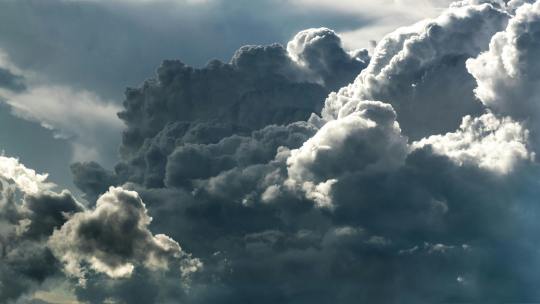
Conclusion:
Clouds are not just passive elements of the sky; they are dynamic indicators of atmospheric conditions that play a vital role in weather forecasting. By understanding the different types of clouds and their characteristics, meteorologists can decipher the complexities of the atmosphere and provide accurate weather forecasts that help communities prepare for and mitigate the impacts of various weather phenomena. As technology advances, including satellite imagery and computer models, our ability to interpret cloud patterns continues to improve, enhancing the precision of weather forecasts and increasing our resilience to weather-related hazards.
1 note
·
View note
Text
Essential Tips for Planning a Weather-Proof Vacation

Planning a vacation is an exciting endeavor, but unpredictable weather can sometimes throw a wrench into even the most carefully laid plans. Whether you're embarking on a beach getaway, a mountain retreat, or an urban exploration, being prepared for various weather conditions can make all the difference in ensuring a smooth and enjoyable trip. In this article, we'll explore essential tips for planning a weather-proof vacation, allowing you to make the most of your travels regardless of what Mother Nature has in store.
Research Destination Weather Patterns:
Before setting off on your journey, take the time to research the typical weather patterns of your destination during the time of your visit. Is it prone to sudden rain showers, scorching heat waves, or unexpected cold snaps? Understanding the climate will help you pack appropriate clothing and gear and anticipate any weather-related challenges you may encounter.
Pack Versatile Clothing:
When it comes to packing for a weather-proof vacation, versatility is key. Opt for clothing items that can be layered to accommodate fluctuations in temperature and weather conditions. Lightweight, moisture-wicking fabrics are ideal for warm climates, while waterproof outer layers and insulated clothing are essential for cooler or wetter destinations. Don't forget to pack items like hats, sunglasses, and sunscreen for sun protection, regardless of the forecast.
Check Weather Forecasts Regularly:
Stay updated on the latest weather forecasts for your destination leading up to and during your trip. While long-range forecasts can provide a general idea of what to expect, remember that weather can be unpredictable, so it's essential to monitor changes in real time. Utilize weather apps or websites that offer reliable, location-specific weather forecasts and alerts to help you plan your activities accordingly and avoid getting caught off guard by unexpected weather events.
Have a Flexible Itinerary:
Flexibility is key when planning a weather-proof vacation. While you may have a list of must-see attractions and activities, be prepared to adjust your plans in response to changing weather conditions. Have backup indoor activities or alternative sightseeing options in mind that can be enjoyed rain or shine. Embrace spontaneity and be open to new experiences, even if they deviate from your original itinerary.
Invest in Travel Insurance:
Protect your vacation investment by purchasing comprehensive travel insurance that includes coverage for weather-related disruptions. Weather can impact travel arrangements such as flights, accommodations, and excursions, leading to unforeseen expenses and inconveniences. Travel insurance can provide peace of mind knowing that you're financially protected in the event of cancellations, delays, or other weather-related mishaps.
Stay Informed During Your Trip:
Once you've arrived at your destination, stay informed about local weather conditions and any potential hazards or advisories issued by local authorities. Pay attention to weather updates broadcast on television, radio, or through official weather channels. If you're venturing into nature or participating in outdoor activities, heed any warnings or guidelines provided by park rangers or tour operators to ensure your safety.
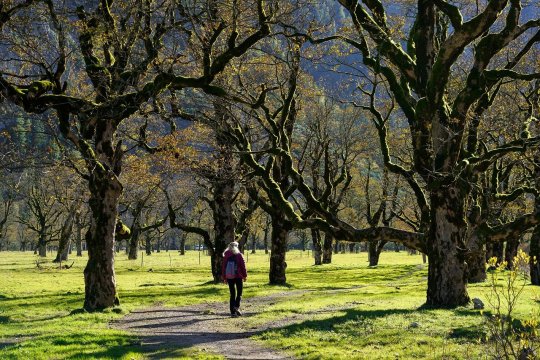
Be Prepared for Emergency Situations:
While no one wants to think about emergencies occurring during their vacation, it's essential to be prepared for the unexpected. Pack a basic emergency kit containing essentials such as first aid supplies, a flashlight, a portable charger, snacks, and bottled water. Familiarize yourself with emergency procedures at your accommodations and have a communication plan in place with your travel companions in case of separation or evacuation.
Conclusion:
Planning a weather-proof vacation requires careful consideration and preparation, but the effort pays off in the form of a more enjoyable and stress-free travel experience. By researching destination weather patterns, packing versatile clothing, staying informed about weather forecasts, maintaining flexibility in your itinerary, investing in travel insurance, staying informed during your trip, and being prepared for emergencies, you can mitigate the impact of adverse weather conditions and make the most of your time away. With proper planning and a positive attitude, you'll be ready to weather any storm and create lasting memories on your next vacation.
1 note
·
View note
Text
Exploring Leeds: A Tapestry of History, Culture, and Weather
Nestled in the core of West Yorkshire, England, Leeds emerges as a vibrant mosaic interwoven with its rich past, diverse culture, and ever-shifting weather patterns. Spanning centuries, the narrative of Leeds reflects resilience, ingenuity, and evolution, molding its essence and essence over time.

Delving into the Past:
Leeds traces its roots back to medieval times, its name is believed to originate from the Old English term "Loidis", symbolizing wooded terrain. From as early as the 5th century, Celtic and Anglo-Saxon tribes inhabited the region, laying the groundwork for what would blossom into a bustling urban hub.
Yet, it was during the Industrial Revolution of the 18th and 19th centuries that Leeds witnessed its true metamorphosis. Fueled by the thriving textile industry, particularly wool production, the city experienced unprecedented expansion and prosperity. Mills and factories proliferated, drawing migrants seeking opportunities. Rapidly, Leeds earned renown as the "Wool Capital of the World," dominating global markets with its textile exports.
Today, remnants of Leeds industrial past stand as silent sentinels, reminders of a bygone era. Yet, the city continues to evolve, embracing change while honoring its heritage. From historic landmarks to modern skyscrapers, Leeds is a testament to resilience and renewal, and its story is a testament to the indomitable spirit of its people.
Preserving Heritage and Inheritance:
One of the most striking examples of Leeds' commitment to preserving its heritage is evident in its architectural landscape. Iconic landmarks such as the Leeds Corn Exchange and Temple Works stand as proud reminders of the city's industrial prowess, their imposing facades telling stories of innovation and enterprise. These historic buildings have been lovingly restored and repurposed, serving as vibrant hubs of commerce, culture, and community.

Moreover, Leeds boasts an impressive array of museums, galleries, and heritage sites, each offering a glimpse into the city's storied past. The Leeds City Museum, for example, showcases artifacts spanning centuries of history, from ancient Roman relics to contemporary cultural treasures. Similarly, the Royal Armouries Museum offers a fascinating insight into Leeds' martial heritage, housing one of the most extensive collections of arms and armor in the world.
Beyond its physical landmarks, Leeds cultural institutions play a vital role in preserving and promoting its heritage. The city's theaters, music venues, and art galleries celebrate its artistic legacy, providing a platform for local talent and international artists alike. Events such as the Leeds International Film Festival and Leeds Light Night further underscore the city's dedication to cultural preservation and innovation.
A Cultural Kaleidoscope:
Beyond its historical significance, Leeds pulsates with a vibrant cultural scene, brimming with creativity and dynamism. The city hosts a diverse spectrum of artistic expressions, from riveting theater productions to avant-garde exhibitions.
The Leeds Playhouse, formerly the West Yorkshire Playhouse, stands as a beacon of theatrical brilliance, captivating audiences with its innovative performances. Similarly, music aficionados flock to venues such as the First Direct Arena and Brudenell Social Club, indulging in a melodic tapestry woven by local and international acts.
Moreover, Leeds' culinary landscape mirrors its cultural diversity, offering a cornucopia of flavors from across the globe. Whether relishing traditional Yorkshire fare or exploring exotic cuisines, gastronomes find themselves spoilt for choice.
Navigating the Elements:
The Leeds' weather is characterized by its maritime climate, with mild winters, cool summers, and regular rainfall throughout the year. The city's proximity to the Pennines exerts influence, with sporadic snowfall lending a wintry charm.
While Leeds is accustomed to occasional downpours, its inhabitants embrace the capricious weather with resilience. Green spaces like Roundhay Park and Temple Newsam offer serene sanctuaries during sunny intervals, while snug cafes and pubs provide refuge during chillier, wetter spells.
In Conclusion:
Leeds emerges as a captivating amalgamation of bygone eras, contemporary vibrancy, and ever-changing climates. From its industrial origins to its modern allure, the city evolves, navigating the currents of time with grace. Whether exploring historical landmarks, immersing oneself in cultural treasures, or indulging in culinary delights, Leeds invites visitors to embark on an enchanting journey through its dynamic tapestry.
1 note
·
View note